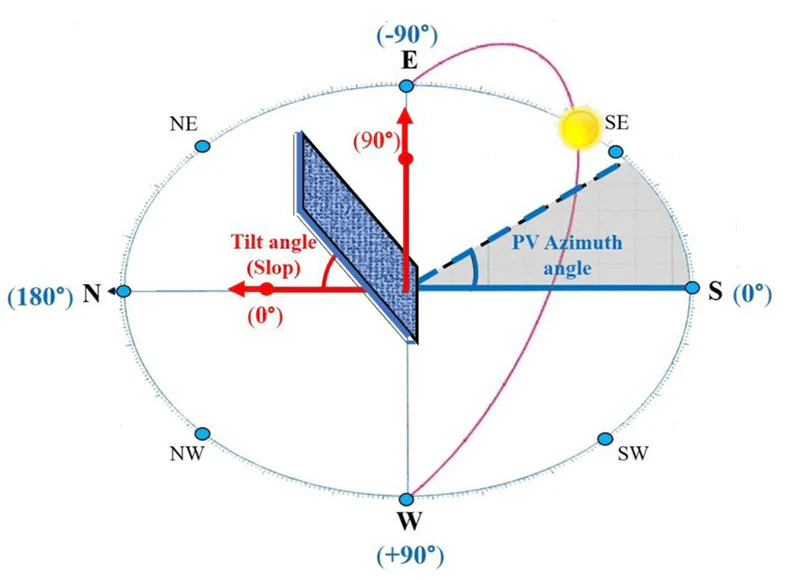
Understanding Solar Panel Angles
Solar panel angles play a pivotal role in optimizing the efficiency of solar energy collection. The angle at which solar panels are installed can significantly affect their ability to absorb sunlight, which is essential for maximizing energy output. The sun’s path varies throughout the year due to the tilt of the Earth’s axis, leading to changes in the optimal angle for solar panels. Understanding this relationship is crucial for ensuring that solar installations yield maximum energy production.
In general, solar panels should be tilted to match the latitude of the installation location. This tilt maximizes exposure to the sun’s rays, particularly during peak sunlight hours. For instance, regions located further north will benefit from a steeper angle to capture low winter sun, while southern locations may utilize a flatter angle to harness sunlight during the high summer months. Additionally, seasonal variations encourage different angles of inclination to be used, allowing panels to adapt to changes in sun position throughout the year.
Furthermore, the orientation of solar panels—whether facing directly south, southeast, or southwest—also impacts energy collection. South-facing panels tend to receive the most direct sunlight, while east and west orientations may still be effective but usually yield slightly less energy. In tandem with tilt adjustments, optimal orientation ensures that panels are positioned to catch the sun’s rays as efficiently as possible.
By considering both the tilt and orientation of solar panels in relation to geographic location and seasonal changes, users can significantly enhance the overall efficiency and output of their solar energy systems. Proper alignment not only improves energy collection but also extends the longevity and performance of solar installations throughout their operational lifespan.
Optimal Solar Panel Angles by Region
The efficiency of solar panels significantly depends on their angle of installation, which should align with the sun’s trajectory for optimal energy capture. Each region of the United States exhibits unique geographical and climatic characteristics, necessitating tailored angle recommendations. Understanding these specifics can assist homeowners and businesses in maximizing their solar energy production.

In the Northeast, where the latitude ranges from approximately 40 to 46 degrees, a tilt angle of around 30 to 40 degrees is generally recommended. This angle helps accommodate the region’s cold winters and enhances energy capture during the shorter days of winter. Given that snow can accumulate on solar panels, maintaining a steeper angle can also facilitate snow shedding, thereby improving efficiency.
The Southeast experiences warmer temperatures and higher humidity levels, with latitudes between 30 and 35 degrees. A tilt angle of about 25 to 30 degrees is optimal in this region. This angle allows for effective energy production throughout the year, especially in summer when prolonged sunlight is prevalent.
For the Midwest, characterized by a range of latitudes from 38 to 43 degrees, a tilt of approximately 30 to 35 degrees is advisable. This inclination balances solar energy absorption during the summer months, while also adequately accounting for the winter sun’s lower angle.
In the Southwest, with its sunny disposition and latitudes spanning 32 to 37 degrees, a tilt angle of about 20 to 25 degrees is efficient. This lower angle capitalizes on the direct sunlight that the region receives, which is crucial for maximizing solar power generation, especially during the peak production months.
Finally, in the Northwest, where the latitude can range from 45 to 50 degrees, a steeper tilt of 40 to 50 degrees is beneficial. This angle compensates for the region’s frequent overcast conditions and captures the sunlight effectively during late spring and early summer.
Account for regional weather patterns and seasonal sun shifts when determining the optimal solar panel angles, as these variables directly influence overall energy production efficacy.
Adjusting Solar Panel Angles Seasonally
For homeowners utilizing solar energy systems, understanding the importance of seasonal adjustments for solar panel angles can significantly enhance energy efficiency. The sun’s trajectory shifts throughout the year, influenced by the Earth’s tilt and orbit. By recalibrating the tilt of solar panels during summer and winter, homeowners can optimize the capturing of sunlight, leading to improved energy output.
During the summer months, the sun is higher in the sky, which means that solar panels should be angled at a lower tilt to maximize exposure to direct sunlight. A tilt that corresponds to the latitude of the installation site, decreased by approximately 15 degrees, can lead to optimal energy capture. Conversely, in winter, the sun travels along a lower path, thus requiring panels to be tilted at a steeper angle. Raising the angle by about 15 degrees relative to the latitude can allow for maximum solar exposure during these months.
To implement these adjustments effectively, homeowners can utilize various tools and techniques. A solar angle calculator is an excellent resource for determining the precise degrees needed for tilt adjustments throughout different seasons. Additionally, some solar panel mounting systems are designed with a degree of adjustability, making it easier to shift angles as needed. Manual tools, like a protractor or angle finder, can also assist in accurately changing the tilt once a calculation has been made.
Moreover, regular maintenance checks can help to ensure the panels are not only positioned correctly but also free of debris that could obstruct sunlight. Ultimately, periodic angle adjustments in line with seasonal changes can maximize solar energy production, making the most out of your solar investment.
Case Studies: Real-World Examples of Angle Adjustments
To better understand the impact of proper solar panel angles on energy production, various case studies demonstrate real-life implementations and their results. These examples showcase how homeowners and businesses across the United States have optimized their solar energy systems to achieve maximum efficiency.
One notable case involves a residential setup in Phoenix, Arizona. Initially, the solar panels were installed at a fixed angle of 20 degrees, typical for the region. However, after realizing the potential for increased energy yield, the homeowner adjusted the angle to 30 degrees during a mid-winter review. This change led to a substantial increase in energy production of approximately 15% over the subsequent months, as it allowed the panels to capture more direct sunlight during the low sun angle period of winter. The homeowner noted, “It was eye-opening to see the difference; our electricity bills dropped significantly after making the adjustment.”
Another example comes from a commercial solar installation in Minneapolis, Minnesota. This company initially set up their arrays at an angle of 40 degrees, which they believed was appropriate for their region. However, after consulting with a solar energy specialist, they modified the angle to a steeper 50 degrees for winter months, which was particularly beneficial during snowy periods. The adjustment resulted in a 20% increase in energy output during the winter months, as the steeper angle helped in shedding snow off the panels more effectively. The facility manager expressed satisfaction stating, “The modification not only improved our energy efficiency but also reduced maintenance costs related to snow removal.”
These case studies highlight the importance of adapting solar panel angles to local climatic conditions, illustrating that thoughtful adjustments can lead to significant improvements in energy production. Actual measurements pre- and post-adjustment documents provide clear evidence of efficiency gains, paving the way for others to consider similar upgrades in their solar energy systems.
